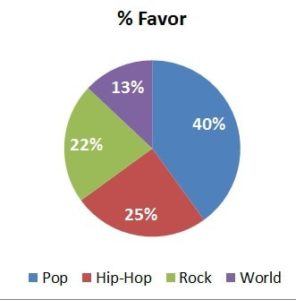Two Examples of the Bias of At-Large Voting: From Non-election Settings
The examples show how the use of standard plurality At-Large voting method allows one voting block to determine not just their fair share but all the choices. Under plurality at-large voting rules, voters may cast as many votes as there are choices. They may only mark one vote for each choice.
Choosing Music for a Prom
100 students are asked to select five songs they want featured at their prom. 20 songs are listed on the ballot, five each in the genres of Pop, Hip-Hop, Rock, and World music. 40 of the students preferred Pop, 25 Hip Hop, 22 Rock and 13 World.
The results if the students cast their five allotted votes one each for the songs in their favorite genre.
| o Each of the 5 Pop songs gets | 40 votes |
| o …Hip-Hop songs get | 25 votes |
| o …Rock songs get | 22 votes |
| o …World music songs | 13 votes |
Under standard At-Large voting rules, only pop music would get played. Even if the students had varied their choices, it’s easy for the largest block dominate. A more proportional result which students would likely have been fine with – would be two pop songs chosen along with one each from the other genres.
Choosing Goals at Board Retreat
20 board members are asked to vote for 5 of 10 goals for their organization from a list on a whiteboard. Each is given five stickers to place next to their five top choices. Using standard At-Large voting rules, they may only put one sticker next to each choice. This allows half the group if they vote cohesively to determine all five choices. The voting method does not give board members any way to indicate how strong their preference was among their choices or the intensity of support for other goals by the others in the room.
That’s why it’s common, even required by many corporate by-laws, to use the cumulative voting method and allow participants to cast their five votes anyway they want. Giving, for example, two, three or all five votes to their most preferred choice(s). The final result is a more genuine reflection of overall agreement among the group. Cumulative voting is commonly used by group facilitators as a method to collectively prioritize options generated from a brainstorming session within a workshop.
Resources
- Cumulative Voting – A Video
- At Large Voting – Frequently Asked Questions, NACCP Legal Defense Fund – View Here
- 10 Things to Know About At Large Voting in Lowell, MA, Nonprofit VOTE – View Here




